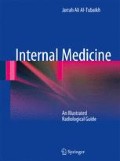Abstract
Intracranial hemorrhage is a condition characterized by the presence of free blood within the cranium. The free blood can be collected in the epidural space, sub-dural space, subarachnoid space, intrabrain parenchyma, or intraventricular spaces.
Intracranial hemorrhage can be caused by head trauma, anticoagulants use, ruptured aneurysms, vascular malformations, and hypertension. The most common areas of intracranial hemorrhage are the temporo-parietal region and the cerebellum. Native, nonenhanced CT is the diagnostic modality of choice as an initial diagnostic modality to detect intracranial bleeding.
Access this chapter
Tax calculation will be finalised at checkout
Purchases are for personal use only
For Further Reading
Xi G et al Intracerebral hemorrhage, pathophysiology and therapy. Neurocrit Care. 2004;1:5–18
Schellinger PD et al Intracranial hemorrhage, the role of magnetic resonance imaging. Neurocrit Care. 2004;1: 31–45
Laguna P et al Intracranial hemorrhage in a boy with severe haemophilia A and factor VIII inhibitor. Child's Nerv Syst. 2006;22:432–5
Dincsoy MY et al Intracranial hemorrhage in hypothalamic low-birth-weight neonates. Child's Nerv Syst. 1990;6: 245–9
Heros RC et al Cerebral vasospasm after subarachnoid hemorrhage: an update. Ann Neurol. 1983;14:599–608
Koc RK et al Acute subdural hematoma: outcome and outcome prediction. Neurosurg Rev. 1997;20:239–44
Gross A et al Intraventricular hemorrhage originating from choroids plexues angioma in a road accident victim. Z Rechtsmed. 1989;102:409–13
Schwartz DT. Sensitivity of computed tomography for sub-arachnoid hemorrhage. doi:10.1016/j.annemergmed. 2008. 06. 471
Moster ML et al Chronic subdural hematoma with transient neurological deficits: a review of 15 cases. Ann Neurol. 1983; 14:539–42
Masuzawa T et al Computed tomographic evolution of post-traumatic subdural hygroma in young adults. Neuroradiology. 1948;26:245–8
Park CK et al Spontaneous evolution of post-traumatic subdural hygroma into chronic subdural hematoma. Acta Neurochir (Wien). 1994;127:41–7
Masuzawa T et al Computed tomography evolution of post-traumatic subdural hygroma in young adults. Neuro-radiology. 1984;26:245–8
Editor information
Editors and Affiliations
Rights and permissions
Copyright information
© 2010 Springer-Verlag Berlin Heidelberg
About this chapter
Cite this chapter
Al-Tubaikh, J.A. (2010). Intracranial Hemorrhage. In: Al-Tubaikh, J.A. (eds) Internal Medicine. Springer, Berlin, Heidelberg. https://doi.org/10.1007/978-3-642-03709-2_8
Download citation
DOI: https://doi.org/10.1007/978-3-642-03709-2_8
Publisher Name: Springer, Berlin, Heidelberg
Print ISBN: 978-3-642-03708-5
Online ISBN: 978-3-642-03709-2
eBook Packages: MedicineMedicine (R0)

